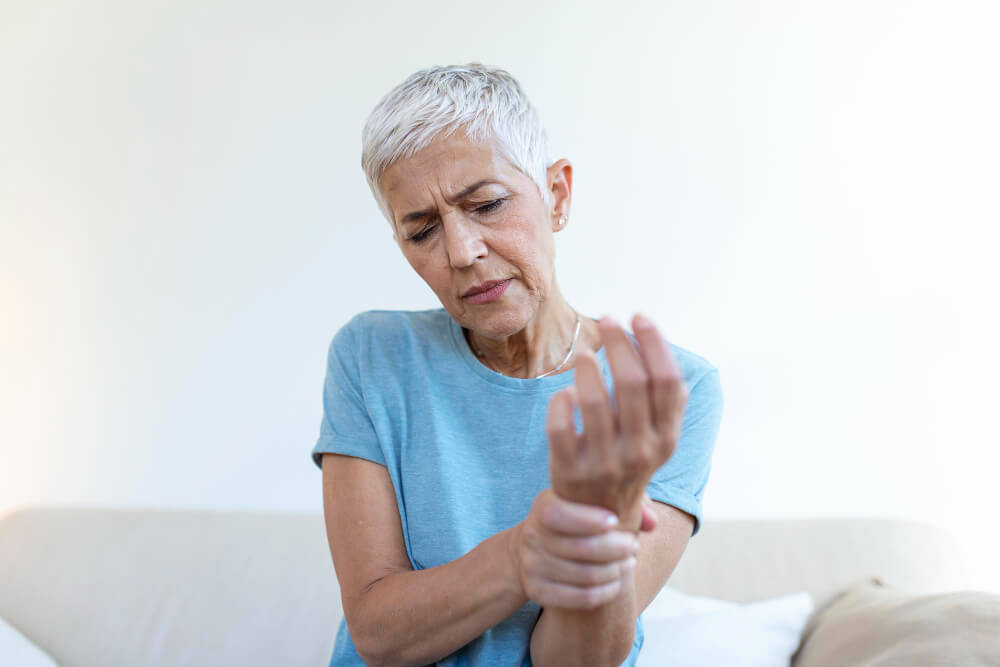Understanding and Combating Osteonecrosis: A Guide to Symptoms, Causes, and Treatment
Osteonecrosis, also known as avascular necrosis, is a condition that disrupts blood flow to your bones, leading to bone tissue death. This can cause significant pain, joint stiffness, and eventually, joint collapse. While osteonecrosis can affect any bone, it most commonly targets the hip, knee, shoulder, and ankle.
This article serves as a comprehensive guide to understanding osteonecrosis. We’ll delve into the symptoms, causes, risk factors, and available treatment options to empower you with knowledge and hope.

Recognizing the Signs: Symptoms of Osteonecrosis
The early stages of osteonecrosis often present with no symptoms. However, as the bone tissue starts deteriorating, you might experience:
- Joint Pain: This is the most common symptom, typically occurring in the affected joint. Initially, the pain might arise only with weight-bearing activities (walking, standing) but can progress to constant pain, even at rest.
- Joint Stiffness: As the bone weakens, the surrounding joint can become stiff, limiting your range of motion.
- Swelling: Inflammation around the affected joint might cause swelling.
- Reduced Mobility: The combination of pain and stiffness can significantly restrict your ability to move freely.
When to See a Doctor
If you experience persistent joint pain, especially in your hip, knee, shoulder, or ankle, consult a healthcare professional promptly. Early diagnosis is crucial for successful treatment and preventing joint damage.
Unveiling the Culprits: Causes of Osteonecrosis
Several factors can contribute to the development of osteonecrosis:
- Disrupted Blood Supply: This is the primary cause. Without adequate blood flow, bone tissue doesn’t receive the necessary oxygen and nutrients to survive, leading to cell death.
- Steroid Use: Long-term use of high-dose corticosteroids can increase the risk of osteonecrosis, particularly for high-potency medications like prednisone.
- Alcohol Abuse: Excessive alcohol consumption can interfere with blood flow and contribute to bone death.
- Medical Conditions: Certain medical conditions, including sickle cell disease, Gaucher’s disease, and systemic lupus erythematosus (SLE), are linked to an increased risk of osteonecrosis.
- Trauma: Injuries, such as fractures or dislocations, can damage blood vessels and disrupt blood flow to the bone, leading to osteonecrosis.
- Caisson Disease: Rapid decompression experienced by divers can cause gas bubbles to form in the blood, potentially leading to osteonecrosis.
Risk Factors for Osteonecrosis
While the exact causes might differ, certain factors can make you more susceptible to developing osteonecrosis:
- Age: Osteonecrosis is more common in individuals between 30 and 50 years old.
- Sex: Men are more likely to develop osteonecrosis than women.
- Certain Medications: Medications like bisphosphonates, used to treat osteoporosis, can increase the risk in some cases.
- Family History: Having a family member with osteonecrosis slightly increases your risk.
Diagnosis and Detecting Osteonecrosis
Diagnosing osteonecrosis often involves a two-pronged approach:
- Medical History and Physical Examination: Your doctor will inquire about your symptoms, medical history, and risk factors. They will also perform a physical examination to assess the affected joint for pain, tenderness, and range of motion.
- Imaging Tests: X-rays might be used initially, but they may not detect osteonecrosis in the early stages. Magnetic resonance imaging (MRI) is a more reliable tool to detect early changes in the bone and surrounding tissues. A bone scan may also be used in some cases.
Early diagnosis is crucial for successful treatment and preventing joint damage.
Taking Control: Treatment Options for Osteonecrosis
Treatment for osteonecrosis aims to manage pain, prevent further bone damage, and preserve joint function. The specific approach often depends on the severity of the condition and the affected bone.
Non-Surgical Treatments

- Pain Management: Medications like pain relievers and anti-inflammatories can help manage pain and inflammation.
- Physical Therapy: Exercises can help maintain joint mobility and strengthen muscles around the affected joint.
- Weight Management: Maintaining a healthy weight reduces stress on the joints, especially the hips and knees.
- Lifestyle Modifications: Depending on the cause, quitting smoking, reducing alcohol consumption, and following a healthy diet can be beneficial.
Surgical Treatments
If non-surgical approaches fail to alleviate symptoms or slow disease progression, surgery might be recommended. The type of surgery will depend on the severity of the condition, the affected bone, and the patient’s age and overall health.
Here’s a breakdown of some common surgical interventions for osteonecrosis:
- Core Decompression: This minimally invasive procedure involves drilling small holes in the affected bone to create channels for new blood vessels to grow and improve blood flow. This can stimulate bone healing and delay joint collapse. Core decompression is often most effective in the early stages of osteonecrosis.
- Bone Grafting: In some cases, core decompression might be combined with bone grafting. This involves transplanting healthy bone tissue into the affected area to promote bone growth and support the damaged area.
- Joint Replacement: If the joint has already collapsed or significantly deteriorated due to osteonecrosis, a total joint replacement surgery might be necessary. This surgery involves removing the damaged joint surfaces and replacing them with artificial implants made of metal, plastic, or ceramic. Joint replacement offers significant pain relief and improved joint function.
Rehabilitation After Surgery
Following surgery, a comprehensive rehabilitation program is crucial for optimal recovery. This might involve physical therapy to regain strength, flexibility, and range of motion in the affected joint.
Weighing the Options: Choosing the Right Treatment
The decision regarding the appropriate treatment approach will be made by your doctor in consultation with you, considering factors such as:
- Severity of osteonecrosis
- Stage of the disease
- Affected bone
- Overall health and age
- Activity level and lifestyle expectations
Living with Osteonecrosis
While osteonecrosis can be a challenging condition, with proper treatment and management, it’s possible to maintain a good quality of life. Here are some tips for living with osteonecrosis:
- Maintain a Healthy Lifestyle: A balanced diet, regular exercise (as tolerated), and managing stress can contribute to overall well-being and potentially slow disease progression.
- Maintain a Healthy Weight: Excess weight puts additional stress on your joints, especially the hips and knees. Weight management can significantly improve symptoms and slow joint deterioration.
- Manage Pain Effectively: Work with your doctor to develop a pain management plan that includes medication and non-medicinal approaches like physical therapy or heat/cold therapy.
- Regular Follow-Up Appointments: Regular check-ups with your doctor are crucial to monitor your condition and adjust treatment plans as needed.
- Support Groups: Connecting with others who understand the challenges of osteonecrosis can be a valuable source of support and information.
The Future of Osteonecrosis Treatment
Researchers are actively exploring new and innovative treatments for osteonecrosis. Some promising areas of research include:
- Stem Cell Therapy: Studies are investigating the potential of using stem cells to promote bone regeneration and repair in osteonecrosis.
- Gene Therapy: Gene therapy research aims to modify genes responsible for bone death to promote healthy bone growth.
- Targeted Medications: Developing medications that specifically target the underlying mechanisms of osteonecrosis to prevent bone death and promote healing.
Conclusion
Osteonecrosis, while a serious condition, can be managed with effective treatment strategies to minimize pain and maintain joint function. Early diagnosis is crucial, and consulting with a healthcare professional if you experience persistent joint pain is vital. With proper treatment and self-care, you can live a fulfilling and active life despite osteonecrosis.
